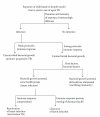Pathogenesis, immunology, and diagnosis of latent Mycobacterium tuberculosis infection
- PMID: 21234341
- PMCID: PMC3017943
- DOI: 10.1155/2011/814943
Pathogenesis, immunology, and diagnosis of latent Mycobacterium tuberculosis infection
Abstract
Phagocytosis of tubercle bacilli by antigen-presenting cells in human lung alveoli initiates a complex infection process by Mycobacterium tuberculosis and a potentially protective immune response by the host. M. tuberculosis has devoted a large part of its genome towards functions that allow it to successfully establish latent or progressive infection in the majority of infected individuals. The failure of immune-mediated clearance is due to multiple strategies adopted by M. tuberculosis that blunt the microbicidal mechanisms of infected immune cells and formation of distinct granulomatous lesions that differ in their ability to support or suppress the persistence of viable M. tuberculosis. In this paper, current understanding of various immune processes that lead to the establishment of latent M. tuberculosis infection, bacterial spreading, persistence, reactivation, and waning or elimination of latent infection as well as new diagnostic approaches being used for identification of latently infected individuals for possible control of tuberculosis epidemic are described.
Figures
References
-
- Cole ST, Brosch R, Parkhill J, et al. Deciphering the biology of Mycobacterium tuberculosis from the complete genome sequence. Nature. 1998;393(6685):537–544. - PubMed
-
- World Health Organization. WHO/HTM/TB/2009.411. Geneva, Switzerland: WHO; 2009. Global tuberculosis control: surveillance, planning and financing.
-
- Dye C, Scheele S, Dolin P, Pathania V, Raviglione MC. Consensus statement. Global burden of tuberculosis: estimated incidence, prevalence, and mortality by country. WHO Global Surveillance and Monitoring Project. JAMA. 1999;282(7):677–686. - PubMed
Publication types
MeSH terms
LinkOut - more resources
Full Text Sources
Other Literature Sources


